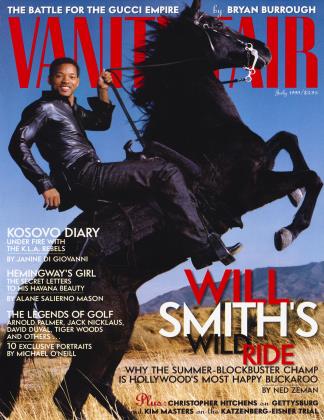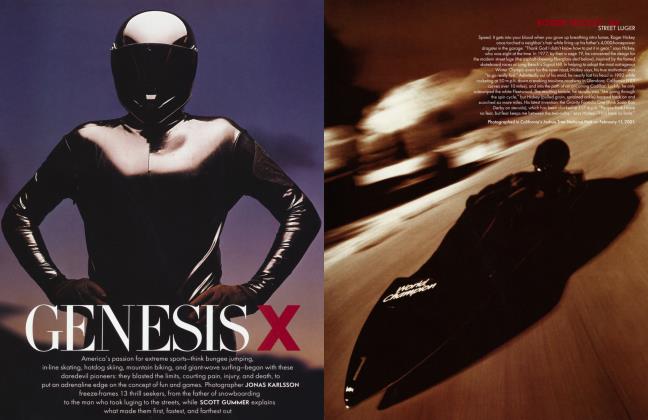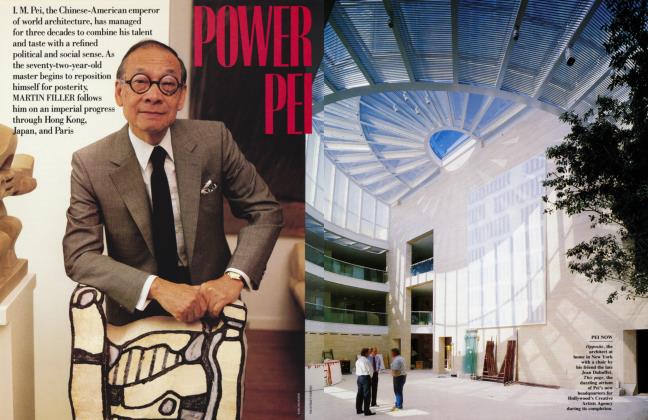Sign In to Your Account
Subscribers have complete access to the archive.
Sign In Not a Subscriber?Join NowGREEN GIANTS
GOLDEN BEAR
JACK NICKLAUS, 59
His grandkids call him PeePaw. To the rest of us, he's the Golden Bear—a nickname he earned as a stocky kid with a tight blond crew cut who brazenly wrested the 1962 U.S. Open from His Majesty Arnold Palmer. Today, Jack Nicklaus is thought of as simply the best who ever picked up a golf club. No one can claim more major titles, including three British Opens, four U.S. Opens, and five P.G.A. Championships. Ask his golden retriever, Cali, how many times Daddy's won the Masters and she'll bark six times. He is also one of the game's most respected golf-course designers (170 in two dozen nations), as well as a world-class fisherman. Check out the 1,358-pound black marlin hanging in his guesthouse. "I don't have any illusions of coming back and competing with the Tiger Woodses and David Duvals," Nicklaus, now on the rebound from recent hip-replacement surgery, has said. "But if I can just scare t hem every once in a while, that will be fine."
Photographed at home aboard his 80-foot Sea Bear, near his private putting green (near right) in North Palm Beach, Florida, on March 24, 1999.
Their names form a glorious roster of golf's American Century: passionate pioneers such as Sam Snead, Gene Sarazen, and Patty Berg giving way to fresh legends—Arnold Palmer, Jack Nicklaus, Nancy Lopez— who are now letting a new generation, led by top-ranked David Duval and phenomenon Tiger Woods, play through. Photographer MICHAEL O'NEILL captures the form of 16 of the game's greatest champions, past and future, while SCOTT GUMMER checks their scorecards
SCOTT GUMMER
THE BLACK KNIGHT
GARY PLAYER, 63
"I didn't want to be poor." With that goal as motivation,
Gary Player worked his way out of an impoverished childhood in South Africa to become golf's consummate international champion. Arguably the world's most traveled athlete, he has spent a total of three years on airplanes over the course of his career, logging more than 12 million miles, equivalent to 25 round-trips to the Moon.
Told by his father that he needed a trademark, Player adopted his dashing black wardrobe in the late 1950s, a tribute to his TV hero, Paladin, from Have Gun Will Travel. Back home in Johannesburg, he raises Thoroughbred racehorses, runs a school for 400 underprivileged black students, and is an innovator in golf-club design. On a recent road trip, when a reporter asked Player what he would do if he had to choose between Vivienne, his wife of 42 years, and his sleek new No. 1 wood, he replied, "I sure would miss her."
Upon returning to his hotel, Player found his beloved club on the bed, draped in a slinky negligee.
Photographed under Balboa Pier in Newport Beach, California, on March 9, 1999.
THE GENTLEMAN
BYRON NELSON, 87
Like most players of his era,
Byron Nelson came up through the caddie ranks, pocketing 50 cents a round; at 15, he won his club's caddie championship in a playoff match against another talented young Texan, named Ben Hogan. He turned pro during the Depression, when the tour was a traveling circus. "We all caravanned from one stop to the next," he remembers fondly. "If someone got a flat tire, everyone pulled over." Then came 1945, Nelson's magic season. In all of sport, his 11 consecutive tournament victories stand as one of the records most likely to endure. He went on to collect 18 titles and earn $63,000 that year—most of it paid in War Bondsthen abruptly retired. The most genteel of champions, Nelson rarely plays 18 anymore, preferring to tinker in the woodshop on his 750-acre cattle ranch, bought with the fruits of that summer of '45.
Photographed at his Fairway Ranch in Roanoke, Texas, on March 17, 1999.
THE HUNTERS
ERNIE EfS, 29, AND LEE WESTWOOD, 26
They areiyoung and hungry, from distant shores, stalking Tiger and setting their sights on David Duval's No. 1 world ranking Two-time U.S. Open victor Ernie Els (far left), piDurly, six-foot-three South African, fired a warning shot earlier this year at L.A.'s Nissan Open when he overcame'final-round challenges by both Woods and Duval. British upstart Lee Westwood, who won seven tournaments in six countries last year, contends that "learning in [more adverse] conditions overseas makes us better fighters" than his Yankee prey. Seemingly at ease in this Florida swamp (home to alligators and poisonous cottonmouth snakes), Els concurs. "International golfers," he says, "are tougher than Americans."
Photographed in Ponte Vedra Beach, Florida, on March 23, 1999.
Golf is different. There are no lockouts, as in basketball. Players don't strike and force the shutdown of the U.S. Open the way baseball players scuttled the World Series in 1994. And golfers don't drop their gloves and pummel one another like hockey thugs (although the idea of contact golf is intriguing).
Golf is hot. The game of kings—once an exclusively Scottish pastime, then a rich man's diversion—is now a game of the people. Securing a Saturday tee time on a decent municipal course is about as tough as landing a table at Rao's. Driving ranges are standingroom-only venues. And programs such as the First Tee are introducing golf to inner-city kids, who might otherwise never have the opportunity to experience the gratifying whoosh of a pitching wedge grazing a patch of Bermuda grass.
Pro golf is huge. For the first time, every P.G.A. tour event will be televised this year, and ratings now routinely eclipse those of N.B.A. broadcasts. Tournament galleries have swelled and taken on a distinctly Happy Gilmore complexion: Every year, 40,000 fans, mistaking the Phoenix Open for spring break, cram around the par-3 16th hole and howl after each player's tee shot. When Tiger Woods drilled a hole in one there two years ago, the horde littered the tee box with beer cups like hockey fans after a hat trick. Even at stately Augusta National, home of the Masters, ladies and gentlemen in shirts with country-club crests share the rope line with guys in tank tops wearing their ball caps backward.
The more things change, the more golf stays the same. Yes, hickory shafts, persimmon woods, and balls made of feathers packed in leather pouches have gone the way of the horsecar, now replaced, in turn, by graphite, titanium, and liquid fillings. And yet the fourround score of 276 that Ernie Els shot to capture the 1997 U.S. Open is precisely the tally that Ben Hogan carded in winning the same tournament a half-century before.
Golf is special. Its fans can literally put themselves in their heroes' shoes. Y>u and your friends can't play three-on-three in Madison Square Garden or softball in Wrigley Field. But you can shoot a round at Pebble Beach, walking the same hallowed ground and hitting from the exact spot where Tiger tees it up. Y>u can play golf with anyone, at any age, anywhere—from the top of the world (where you can duff under the midnight sun near Alaska's Denali National Park) to the Horn of Africa (where players at Sun City's Leopard Creek share the course with lions and elephants).
Golf is ageless. At that stage in life when many jocks are struggling to squeeze one more year out of their careers, many golfers are just hitting their prime. Michael Jordan, possibly the greatest athlete of modem times (and a certified golfaholic), was praised for displaying rare grace and good sense upon retiring from basketball this year at the tender age of 35. By contrast, golf's Jack Nicklaus, often rated the game's greatest player ever, won 18 tour events, including two Masters, two P.G.A. Championships, a British Open, and a U.S. Open—all after turning 35.
Golf doesn't put players out to pasture (unless you happen to shank your shot onto a neighboring farm). And that, more than anything, is the sport's true beauty. No matter how old you get, you never lose your drive. It just takes you longer to score.
THE FIRST LADY AND THE PATRIARCH
PATTY BERG, 81, AND GENE SARAZEN, 97 (SARAZEN DIED ON MAY 13, 1999)
He hit the most famous golf shot in history, a 235-vard double eagle at Augusta in 1935 that helped firmly establish the Masters, then in its second year. She won the inaugural U.S. Women's Open in 1946. He was the first golfer to gain a career Grand Slam by taking the Masters, the P.G.A., and both the British and U.S. Opens.
She still holds the women's mark for most major victories—15.
She locked irons with Babe Didrikson Zaharias. He did battle with Bobby Jones.
She was the first president of the L.P.G.A. He invented the sand wedge. Says Patty Berg of her stylish, competitive friend Gene Sarazen, "I watched him play when I was 13 or 14, a little girl in Minneapolis. I asked for his autograph. He inspired me. Gene had this will to win." When he passed away in May, following a bout with pneumonia, "the Squire," as he was known, represented nearly a century of dedication to a game invented half a millennium ago.
Photographed outside Sarazen's home on Marco Island, Florida, on March 25, 1999.
THE LEADING LADIES
NANCY LOPEZ, 42, AND SE RI PAK, 21
In her hands the golf club has been a magic wand, transporting young Nancy Lopez from her New Mexico home to fairy-tale places like Buckingham Palace, where, at 19, she experienced the ultimate tea party with the Queen. Buoyed by an irrepressible game and an irresistible smile, she captured nine tournaments her first full year on tour, including an L.P.G.A.-record five in a row. Today, competing year-round and tending to a three-child, two-jock household (her husband is former New York Mets star Ray Knight), Lopez (above, left) is the dominant female player of her generation. Charging up history's fairway is South Korean-born, Orlando-based Se Ri Pak, who last year won the first two majors she entered. What keeps champions like these from achieving the fame enjoyed by their male counterparts? The tube, says Lopez. "If we were on TV every week, women's golf would be just as popular," she insists. "Probably more."
Photographed at the North Mountain Recreation Area in Phoenix, on March 16, 1999.
THE FOUR HORSEMEN OF THE MILLENNIUM
PHIL MICKELSON, 29, DAVID DUVAL, 27, JUSTIN LEONARD, 27, AND JIM FURYK, 29
They personify the power, youth, and supremely confident style of golf in the next century. Among them, they have earned close to $30 million and tasted victory more than 30 times—all before their 30th birthdays. Mickelson (far left) has hoisted the most trophies—13—but the hottest player of the year has been Duval (second from left), who supplanted Tiger Woods this spring as the world's highest-ranked pro by winning 11 of his previous 34 tournaments. (By tax day, Duval had eclipsed the record $2.5 million in annual prize money he had set last year.) Leonard (second from right) is the lone gun among them to have claimed a major, the 1997 British Open. And Furyk (above), the most consistent top-10 finisher on the tour over the past two seasons, speaks for this brash, all-American foursome when comparing today's ranks with those of yesteryear: "The competition is so much stiffer now. Any given week, anyone can win." Observes the steely Duval, "The thing that separates good golfers from the greats is not just being comfortable when you are in position to win. You have to thrive on it."
Photographed at the Kapalua Bay Hotel on Maui, Hawaii, on January 6, 1999.
THE MAN
TIGER WOODS, 23
He uses the Force. How else can you explain so many clutch shots that seem to bend toward the pin in midair or roll that extra tick before trickling into the cup? How else can you fathom golf's most explosive debut: an unprecedented 12-stroke romp at the 1997 Masters by a 21-year-old
rookie? And yet, like most young warriors, he is raw. On those occasions when the ball does not obey, he has been known to pound his club into the turf and mutter expletives within earshot of a gallery or microphone. With time, he will harness these emotions of the Dark Side. Only then may Tiger Woods fulfill a prophecy made by Jack Nicklaus and go on to win more Masters green jackets than Nicklaus and Arnold Palmer combined (1 down, 10 to go). Indeed, the force of his personality, youth, and race have helped invigorate an entire sport. Not bad for a kid who started out delighting audiences in a putting contest against Bob Hope on The Mike Douglas Show. At age two.
Photographed in Cypress, California, on January 13.
THE SLAMMER
SAM SNEAD, 87
As a Virginia farm boy, he learned the game tromping barefoot in a pasture, swinging clubs fashioned from swamp-maple limbs. "One-stroke penalty if you raked it out of a cow pie instead of playing it where it lied," he recalls. Blessed with a supple swing that thundered out drives like cannonade, "Slammin' Sam" Snead was as adept around the green as he was long off the tee. He won tournaments across six decades and set marks for most victories (an untouchable 81); eldest champion of an official tournament (52 years 10 months); and first to shoot his age (67), a feat he still does regularly.
"My only regret," confides the indomitable Snead, "is I came along too soon for the big money these flippy-wristed, flat-bellied boys are playing for nowadays."
Photographed at the Hilton Hotel on Marco Island, Florida, on February 17, 1999.
THE KING
ARNOLD PALMER, 69
Sputnik soared. Elvis shimmied And golf on TV was about as compelling as a test pattern Then came Arnold Palmer, giving Americans a reason to watch and a hero to cheer Like a gunslinger right out of his beloved Westerns, Palmer played with a swagger and an unbridled passion that unnerved opponents and endeared him to fans. To this day, battalions from "Arnie's Army" line fairways whenever he tees off. The first golfer to win $100,000 in a season and $1 million in a career, Palmer practically invented the hyphenate "athlete-endorser " He continues to pursue his other boyhood obsession—aviation—having circumnavigated the globe in a learjet 36 in a world-record-setting 57 hours 25 minutes. "If it wasn't for flying, I wouldn't be playing golf today," the King remarked at the height of his reign. "I loathe driving 2,000 miles every Monday."
Photographed on his Cessna Citation X in the "Palmer Hangar" at Florida's Orlando International Airport on February 10, 1999.
 View Full Issue
View Full Issue


















Subscribers have complete access to the archive.
Sign In Not a Subscriber?Join Now